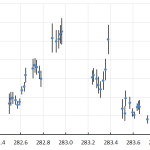Abstract: A summary of the activity of the CAMS BeNeLux network during the month of October 2020 is presented. October 2020 had exceptional poor weather conditions. Despite the uncooperative weather a total of 20135 meteors has been recorded of which 45% was multi-station, resulting in 3305 orbits good quality orbits.
1 Introduction
The long October nights with high meteor activity are probably the most promising month for the CAMS BeNeLux network. Unfortunately, most years it remains with “promising”. Overcast and misty weather is most common during this autumn month in the BeNeLux. Would 2020 bring some good luck with October?
2 October 2020 statistics
3305 orbits could be collected which is the lowest number of orbits for October since 2015 when 8 camera stations less and 43 cameras less were available than this year. 2020 brought really the worst case weather scenario for the month October with not a single complete clear night for the entire network, worse than previous year. Weather wise we probably got the worse month of October since many years.
This month counted 12 nights with more than 100 orbits. The best October night was 22–23 with as many as 461 orbits in a single night. Only two nights remained without any orbits, but most nights meteors got registered between the clouds. In total 20135 meteors were registered of which only 9042 were multistation or 45% with a successful solution for an orbit. The statistics of October 2020 are compared in Figure 1 and Table 1 with the same month in previous years since the start of CAMS BeNeLux in 2012. In 9 years, 228 October nights allowed to obtain orbits with a grand total of 28790 orbits collected during the month of October during all these years together.
Some CAMS stations were not operational due to technical problems or other reasons. October 2019 had a maximum of 76 cameras at 20 CAMS stations, 67.5 on average available while October 2020 had 90 cameras at 23 CAMS stations and 70.9 on average. Even in October 2016 when at best 54 cameras at 19 stations and on average 41.3 cameras were available, some more orbits could be collected.
Again, no really favorable weather occurred for the Orionids apart from some partial clear sky 21–22–23 October. Next year will be the tenth year for CAMS BeNeLux to hope for a first year with lucky weather for the Orionid activity.

Figure 1 – Comparing October 2020 to previous months of October in the CAMS BeNeLux history. The blue bars represent the number of orbits, the red bars the maximum number of cameras running in a single night and the yellow bar the average number of cameras running per night.
Table 1 – October 2020 compared to previous months of October.
| Year | Nights | Orbits | Stations | Max. Cams | Min. Cams | Mean Cams |
| 2012 | 16 | 220 | 6 | 7 | 3.9 | |
| 2013 | 20 | 866 | 10 | 26 | 16.8 | |
| 2014 | 22 | 1262 | 14 | 33 | 19.7 | |
| 2015 | 24 | 2684 | 15 | 47 | 34.8 | |
| 2016 | 30 | 3335 | 19 | 54 | 19 | 41.3 |
| 2017 | 29 | 4163 | 22 | 87 | 45 | 74.4 |
| 2018 | 29 | 9611 | 21 | 82 | 52 | 73.0 |
| 2019 | 29 | 3344 | 20 | 76 | 47 | 67.5 |
| 2020 | 29 | 3305 | 23 | 90 | 52 | 70.9 |
| Total | 228 | 28790 |
3 Conclusion
The weather made October 2020 the poorest since the start of CAMS BeNeLux. The large number of operational cameras running Auto CAMS still allowed to record a very nice number of orbits under these very unfavorable circumstances.
Acknowledgment
Many thanks to all participants in the CAMS BeNeLux network for their dedicated efforts. This report is based on the data from the CAMS-website http://cams.seti.org/FDL/index-BeNeLux.html with thanks to Martin Breukers for providing some extra information and corrections.
The CAMS BeNeLux team was operated by the following volunteers during the month of October 2020: Hans Betlem (Leiden, Netherlands, CAMS 371, 372 and 373), Felix Bettonvil (Utrecht, Netherlands, CAMS 376 and 377), Jean-Marie Biets (Wilderen, Belgium, CAMS 379, 380, 381 and 382), Martin Breukers (Hengelo, Netherlands, CAMS 320, 321, 322, 323, 324, 325, 326 and 327, RMS 328 and 329), Guiseppe Canonaco (Genk, RMS 3815), Bart Dessoy (Zoersel, Belgium, CAMS 397, 398, 804, 805, 806 and 888), Jean-Paul Dumoulin, Dominique Guiot and Christian Walin (Grapfontaine, Belgium, CAMS 814 and 815, RMS 003814), Uwe Glässner (Langenfeld, Germany, RMS 3800), Luc Gobin (Mechelen, Belgium, CAMS 390, 391, 807 and 808), Tioga Gulon (Nancy, France, CAMS 3900 and 3901), Robert Haas (Alphen aan de Rijn, Netherlands, CAMS 3160, 3161, 3162, 3163, 3164, 3165, 3166 and 3167), Robert Haas (Texel, Netherlands, CAMS 810, 811, 812 and 813), Robert Haas / Edwin van Dijk (Burlage, Germany, CAMS 801, 802, 821 and 822), Kees Habraken (Kattendijke, Netherlands, RMS 000378), Klaas Jobse (Oostkapelle, Netherlands, CAMS 3030, 3031, 3032, 3033, 3034, 3035, 3036 and 3037), Carl Johannink (Gronau, Germany, CAMS 311, 314, 317, 318, 3000, 3001, 3002, 3003, 3004 and 3005), Hervé Lamy (Dourbes, Belgium, CAMS 394 and 395), Hervé Lamy (Humain Belgium, CAMS 816), Hervé Lamy (Ukkel, Belgium, CAMS 393), Koen Miskotte (Ermelo, Netherlands, CAMS 351, 352, 353 and 354), Steve Rau (Zillebeke, Belgium, CAMS 3850 and 3852), Paul and Adriana Roggemans (Mechelen, Belgium, CAMS 383, 384, 388, 389, 399 and 809, RMS 003830 and 003831), Hans Schremmer (Niederkruechten, Germany, CAMS 803) and Erwin van Ballegoij (Heesch, Netherlands, CAMS 347 and 348).


